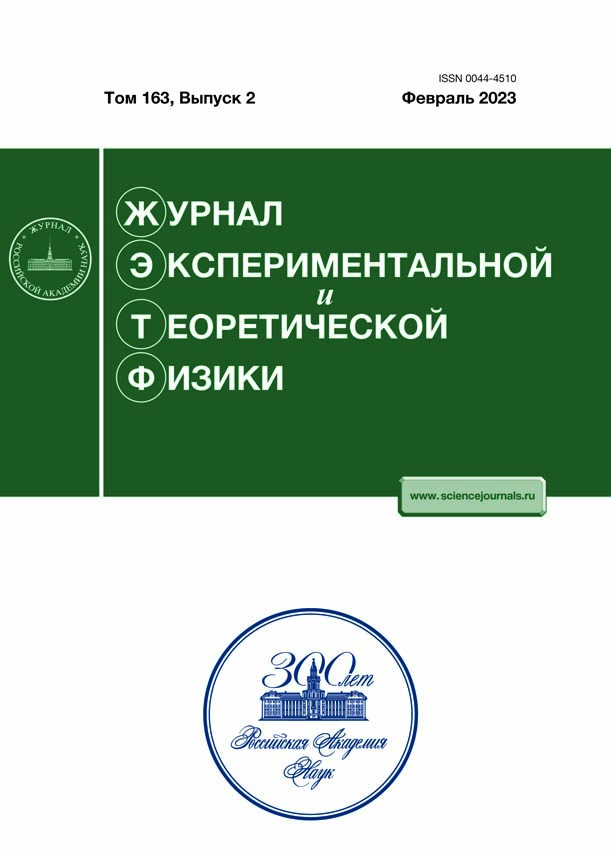On the Problem of Bound States of Electron and Hole in Transition Metal Dichalcogenides
- Авторлар: Krachkov P.A1, Terekhov I.S1
-
Мекемелер:
- Budker Institute of Nuclear Physics
- Шығарылым: Том 163, № 2 (2023)
- Беттер: 227-237
- Бөлім: Articles
- URL: https://archivog.com/0044-4510/article/view/653566
- DOI: https://doi.org/10.31857/S0044451023020098
- EDN: https://elibrary.ru/OQSTQJ
- ID: 653566
Дәйексөз келтіру
Аннотация
The interacting electron and hole in transition metal dichalcogenides are considered. To investigate the interaction the Bethe-Salpeter equation was obtained in the leading order in the interaction potential. It is shown that the behavior of the potential at short distances significantly affects the binding energy of the electron and the hole. We demonstrate that the expansion of the Bethe-Salpeter equation in the small coupling constant does not contain singular operators. Therefore, the binding energy of the electron and the hole does not contain the regularization parameter. Using the perturbation theory in the coupling constant we analytically calculated the energies of the ground and first excited states of the exiton. For arbitrary values of the coupling constant, the energies of the bound states of the electron and the hole are obtained numerically. The critical values of the coupling constant for the Coulomb potential and for the exponentially decreasing potential are also found numerically.
Авторлар туралы
P. Krachkov
Budker Institute of Nuclear Physics
Email: p.a.krachkov@inp.nsk.su
630090, Novosibirsk, Russia
I. Terekhov
Budker Institute of Nuclear Physics
Хат алмасуға жауапты Автор.
Email: i.s.terekhov@inp.nsk.su
630090, Novosibirsk, Russia
Әдебиет тізімі
- K. S. Novoselov et al., Science 306, 666 (2004).
- Z. Y. Zhu, Y. C. Cheng, and U. Schwingenschl¨ogl, Phys. Rev. B 84, 153402 (2011).
- A. S. Rodin and A. H. Castro Neto, Phys. Rev. B 88, 195437 (2013).
- J. Zhou, W.-Y. Shan, W. Yao, and D. Xiao, Phys. Rev. Lett. 115, 166803 (2015).
- M. Trushin, M. O. Goerbig, and W. Belzig, Phys. Rev. B 94, 041301(R) (2016).
- M. Trushin, M. O. Goerbig, and W. Belzig, Phys. Rev. Lett. 120, 187401 (2018).
- M. Trushin, Phys. Rev. B 99, 205307 (2019).
- B. Scharf, D. V. Tuan, I. Zutic, and H. Dery, J. Phys.: Condens. Matter 31, 203001 (2019).
- N. V. Leppenen, L. E. Golub, and E. L. Ivchenko, Phys. Rev. B 102, 155305 (2020).
- M. F. C. Martins Quintela, J. C. G. Henriques, N. M. R. Peres, Phys. Stat. Sol. B, 2200097 (2022).
- В.Б. Берестецкий, Е.М. Лифшиц, Л.П. Питаевский, Квантовая электродинамика, Наука, Москва (1984).
- C. Itzykson, and J.-B. Zuber, Quantum eld theory, McGraw-Hill (1980).
- G. F. Glinskii and Zl. Koinov, Theor. Math. Phys. 70, 252 (1987).
- D. Xiao, G.-B. Liu, W. Feng, X. Xu, and W. Yao, Phys. Rev. Lett. 108, 196802 (2012).
- A. Chernikov, T. C. Berkelbach, H. M. Hill et al., Phys. Rev. Lett. 113, 076802 (2014).
- K. He, N. Kumar, L. Zhao, Z. Wang, K. F. Mak, H. Zhao, and J. Shan, Phys. Rev. Lett. 113, 026803 (2014).
- А. И. Ахиейзер, В. Б. Берестецкий, Квантовая электродинамика, Наука, Москва (1981).
Қосымша файлдар









